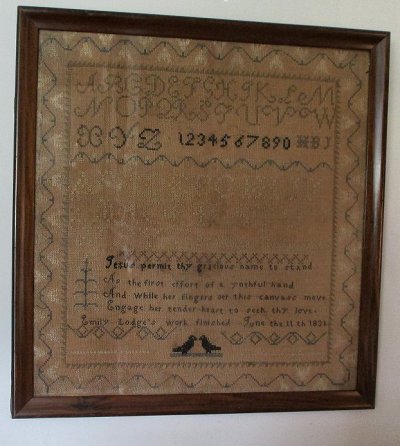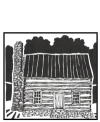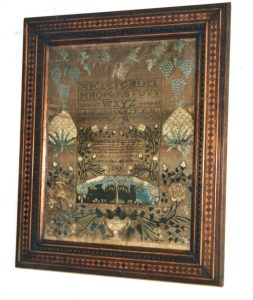A historic sampler has come to light from the earliest days of Snickersville, now called Bluemont.
“Through artifacts like this sampler, we are starting to get a picture of some of the individual children who attended Bluemont’s first school,” said Susan Freis Falknor, president of Friends of Bluemont.
The Snickersville Academy, built in 1825 and now being restored by Friends of Bluemont, continued to educate village children until after the Civil War. William Bradford, veteran of the War of 1812, shoemaker, and the village’s first Postmaster, joined with four other residents to obtain (“for the consideration of one dollar”) a small plot of land from William Clayton. On May 21, 1825, they signed an agreement to act as trustees for the “purpose of building a house for a public school and place of divine worship.”
The elaborately embroidered sampler by Lucy Ann Bradfield, William’s daughter is decorated with the alphabet in print and script as well as the numerals, festooned with grapes, pineapples, rosebuds, ivy vines, and a weeping willow tree. It bears the inscription:
“Lucy Ann Bradfield
Snickersville Academy
1826″
Lucy Ann’s turning eight was probably a major reason that her father helped start a school in Snickersville in 1825. Lucy Ann was the oldest child, with a five-year-old brother George William also growing into his school years.
The frame of inlaid dark and light wood crafted in an elaborate checkerboard pattern testifies to how much Lucy Ann’s family valued her girlhood effort.
Lucy Ann never married. She died in 1857 at age 40 and is buried in Ebenezer cemetery, according to Clara Kelley, manager of the cemetery. She and her husband J.J. Kelley, who live near Bluemont, own the sampler.

The Kelleys have a second sampler that appears to be the effort of another Snickersville Academy scholar. It reads, “Emily Lodge’s work finished June the 11th 1831.”
Emily’s sampler has a four-line version of a verse often found on antique needlework samplers. It is a prayer asking Jesus to allow his name to be the first thing a young child learns to stitch, symbolizing the early imprint of faith on a child’s heart, and guiding her to seek his love as she works on her embroidery. The verse she embroidered may have been written by John Newton a repentant slave merchant who wrote “Amazing Grace” or by hymnist Isaac Watts. Emily married Meshack Silcott and they lived in the house across the street from Carrington House. Snickersville General Store was originally built for John and Meshack Silcott in 1888. Emily and Meshack had seven children, and Emily lived until 1874.

